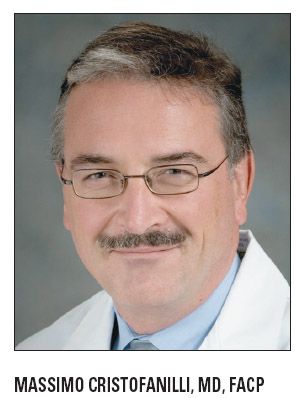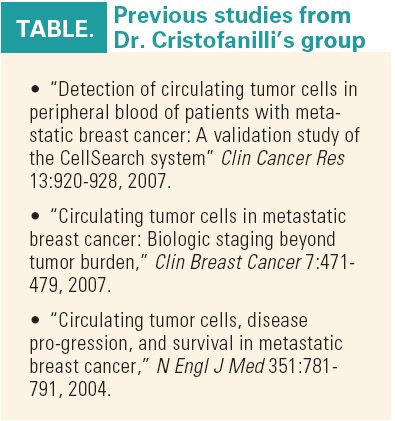Circulating tumor cells edge out imaging in breast mets
Five may be the magic number to determine whether a patient can undergo therapeutic monitoring with a test for circulating tumor cells or must undergo an FDG-PET/CT exam, according to research out of M.D. Anderson Cancer Center.
Five may be the magic number to determine whether a patient can undergo therapeutic monitoring with a test for circulating tumor cells or must undergo an FDG-PET/CT exam, according to research out of M.D. Anderson Cancer Center.

The Houston-based investigators, led by Massimo Cristofanilli, MD, FACP, continue their exploration of CTC counts to predict outcomes in metastatic breast cancer (MBC). They performed a retrospective analysis of 115 patients with advanced disease who had CTC counts and PET/CT scans performed at baseline and at midtherapy (nine and 12 weeks).
For the CTC study, blood samples were analyzed using CellSearch (Veridex). CTCs were defined as nucleated cells that lacked CD45 and that expressed cytokeratin, the authors explained. Blood samples were processed within 72 hours of collection. Patients were characterized according to midtherapy counts. A favorable outcome was less than five CTCs/7.5 mL of blood. An unfavorable outcome was greater than or equal to five CTCs/7.5 mL of blood.
PET/CT scans were done on an integrated system (Discovery ST, STE, or RX; GE Healthcare) and patients were imaged from the orbits to midthighs about one hour after an IV-administered dose of FDG (10-15 mCi). Imaging studies were acquired at three to five minutes per bed position for a total of six or seven positions.

Results
According to the results in 102 patients who were available for evaluation, the median overall survival (OS) was 14 months. Midtherapy CTC levels correlated with PET/CT results in 67% of the patients. In univariate analysis, midtherapy CTC counts (P < .001) and PET/CT (P = .001) predicted OS. However, CTC counts were superior to PET/CT in prognostic value. On multivariate analysis, only midtherapy CTC levels remained significant (P = .004).
“The results of CTC enumeration are more reproducible, seem to predict survival more robustly, and yield useful results earlier than radiographic evaluation,” the authors wrote. “Detection of five or greater CTCs during therapeutic monitoring can accurately predict prognosis in MBC beyond functional response assessed by FDG-PET/CT. FDG-PET/CT deserves a predictive role in instances of patients with less than five CTCs at midtherapy” (J Clin Oncol 27:3303-3311, 2009).

In an interview with Oncology News International, Dr. Cristofanilli discussed the implication of his group’s results in the current shifting healthcare climate. Dr. Cristofanilli is an associate professor in the department of breast medical oncology, division of cancer medicine at M.D. Anderson.
“In a time of health reform and cost reduction, the possibility to use a reliable and reproducible blood test, compared to much more expensive imaging test, is quite appealing,” said Dr. Cristofanilli. He estimated that a single PET/CT study can run as high as $5,000.
“We frequently focus on the cost of new drugs but completely forget how much repeated imaging studies contribute to healthcare costs,” he said.
A prospective study would be needed before the standard of care for MBC monitoring can be changed.
“I believe that we have to start thinking about developing prospective, confirmatory studies under the support of NCI that can provide final demonstration of the validity of such findings,” Dr. Cristofanilli said.
Newsletter
Stay up to date on recent advances in the multidisciplinary approach to cancer.